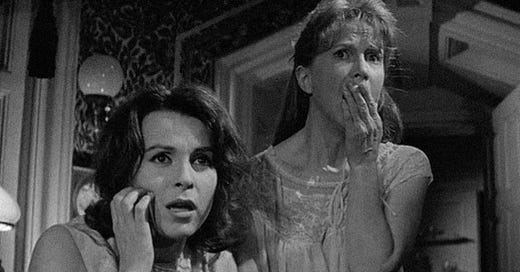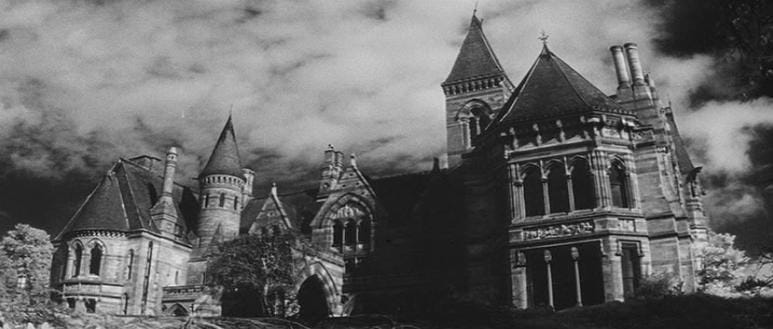Here’s the first post from my new mini-series: for All Hallow’s Eve. I’ll finish off with a free bonus post (which everybody can read) on Hallowe’en itself. That’s on Wednesday. I love Hallowe’en. Always have done. Or put it this way, it turned me on when I was ten years old. For the old British Hallowe’en was a subtle affair. A spooky cartoon on children’s television or a poem, perhaps. Or a homemade cut-out of a witch stuck to a window, and that was about it. In the kitchen of her Buckinghamshire farmhouse, my grandmother taught me how to carve little turnip lanterns, a trick I suspect she learnt from my Scottish-born great-grandmother.
Old copies of The Radio Times (which you can read via the BBC’s fascinating ‘Genome’ project) are a helpful indication of the festival’s waxing and waning popularity over the years, at least in popular culture. In 1975, Hallowe’en fell on a Friday, and there is no mention of the festival on either BBC1 or BBC2. I suspect my parents were barely aware of it. There were more important things to worry about. Things like power cuts, the oil crisis and the three day week. Today, middle-aged grumps find our commercialised Hallowe’en both tacky and tiresome, especially Trick or Treating— an American import to these shores, inspired by films such as the The Exorcist (1973) John Carpenter’s brilliant Halloween (1978) or ET (1982). Yet, there’s a marvellous sequence in The Exorcist (1973), when Ellen Burstyn walks the streets of Georgetown on an autumnal Hallowe’en afternoon, set to the music of Mike Oldfield’s Tubular Bells: there’s a terrific sense of place, of magical possibility. And according to the great Ronald Hutton (who really knows his stuff) Hallowe’en is a North European festival with ancient and historical roots, very much a part of the culture of these isles, even if, as folklorist, Steve Roud points out (and he’s another one who really knows his stuff) the connexion with the supernatural was a Christian creation of the 9th Century— to commemorate the martyrs and the saints.
These days Hallowe’en has become very American. Young office workers go to fancy dress parties dressed as the Munsters. You see them on the Tube or on the street, going to some huge party somewhere. It’s become a sort of mating ritual, a rite of passage— a cattle market, with the boys dressed as toxic Draculas and the girls as tarty Vampiras. And Trick or Treating is now firmly established in Britain. In America, trick or treating is organised, and rather sweet. At least in the Upper East Side— I can’t speak for Texas, land of the chainsaw— where beautifully dressed, well-mannered eight year old Frankensteins stroll into smart restaurants and ask (oh so politely) for candy (sic). Over here, on the mean streets of Sarf London, it’s far more anarchistic, subversive and unruly, coupled as it is with our splendid festival of Bonfire Night. Good old bolshy Blighty! The kiddywinks can’t be bothered with elaborate fancy dress, they just pull on stretchy William Shatner masks, a bit like 1960s armed robbers. The only thing missing is a getaway Jag. I used to turn off the lights and pretend I had gone to Bognor Regis, but the local street urchins soon worked that one out, and rattling their chains, shouted through the letterbox: “ ‘ere, Mishter! We know you’re there!”, although recently, in the last year or two, I’ve noticed less Trick or Treaters out on the streets. They may now only target houses with pumpkins left on the porch. American training is kicking in.
And I have an immense nostalgia for BBC2's late-night horror double bill, shown on Saturday nights back in the late 70s and early 80s. Nothing like an old horror film and a Chicken n' Mushroom Pot Noodle. The first film was always a creaky 30s or 40s black and white flick, completely unscary, like Frankenstein meets the Wolf Man (1943) or The Tower of London (1939) starring Boris Karloff, Vincent Price and Basil Rathbone as Richard, Duke of Gloucester, followed, perhaps much later into the night (and well past the watershed) by something far more sinister: Dennis Wheatley's To the Devil- a Daughter (1979), The Satanic Rites of Dracula (1973) or Freddie Francis' The Skull (1965), starring Peter Cushing as a connoisseur of strange artefacts who covets the skull of the Marquis de Sade. This delightful little number is based on a short story by Robert Bloch, the author of Psycho (1959).
Which takes us to The Haunting (1963). Fancy a night in a haunted house? I can't think of anything better. Seriously, I'd be there with my camera, notebook, chalk and ghostometer. Like a shot. A night in Borley Rectory? Now you're talking! I'm not sure, though, that I believe in ghosts, as such, although I do think that people see, hear—even smell— weird things, as they have done since time immemorial. In my parent's house, an 18th-century Oxfordshire cottage, I once heard mysterious footsteps walk across the ceiling, directly above me— although nobody was there at the time, not even a mouse. And of all the ghost films out there, The Haunting (1963), in my opinion, is one of the best, if not the best film in the genre: subtle, beautifully made, acted and photographed in crisp mid-60s black and white, with weird camera angles and superb locations. It's also genuinely gobsmackingly scary…
Keep reading with a 7-day free trial
Subscribe to Luke Honey's WEEKEND FLICKS. to keep reading this post and get 7 days of free access to the full post archives.







